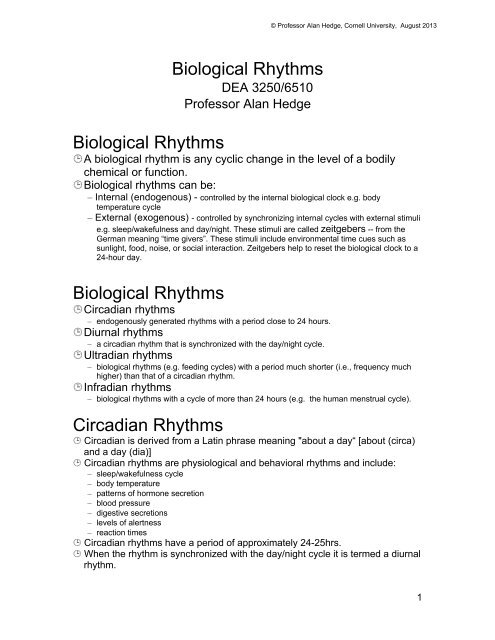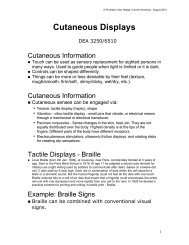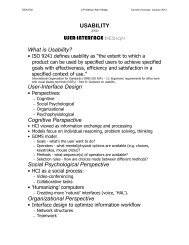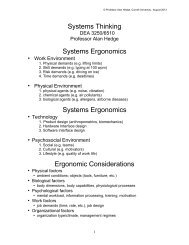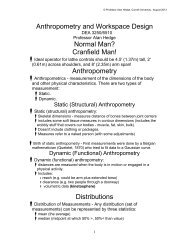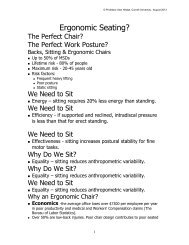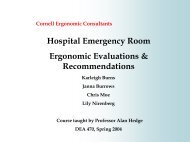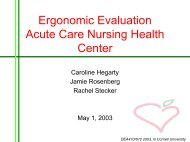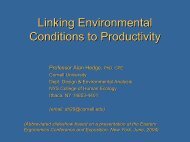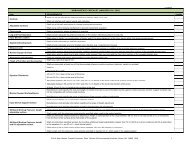Biological Rhythms - Cornell University Ergonomics Web
Biological Rhythms - Cornell University Ergonomics Web
Biological Rhythms - Cornell University Ergonomics Web
Create successful ePaper yourself
Turn your PDF publications into a flip-book with our unique Google optimized e-Paper software.
© Professor Alan Hedge, <strong>Cornell</strong> <strong>University</strong>, August 2013<br />
<strong>Biological</strong> <strong>Rhythms</strong><br />
DEA 3250/6510<br />
Professor Alan Hedge<br />
<strong>Biological</strong> <strong>Rhythms</strong><br />
¹ A biological rhythm is any cyclic change in the level of a bodily<br />
chemical or function.<br />
¹ <strong>Biological</strong> rhythms can be:<br />
– Internal (endogenous) - controlled by the internal biological clock e.g. body<br />
temperature cycle<br />
– External (exogenous) - controlled by synchronizing internal cycles with external stimuli<br />
e.g. sleep/wakefulness and day/night. These stimuli are called zeitgebers -- from the<br />
German meaning “time givers”. These stimuli include environmental time cues such as<br />
sunlight, food, noise, or social interaction. Zeitgebers help to reset the biological clock to a<br />
24-hour day.<br />
<strong>Biological</strong> <strong>Rhythms</strong><br />
¹ Circadian rhythms<br />
– endogenously generated rhythms with a period close to 24 hours.<br />
¹ Diurnal rhythms<br />
– a circadian rhythm that is synchronized with the day/night cycle.<br />
¹ Ultradian rhythms<br />
– biological rhythms (e.g. feeding cycles) with a period much shorter (i.e., frequency much<br />
higher) than that of a circadian rhythm.<br />
¹ Infradian rhythms<br />
– biological rhythms with a cycle of more than 24 hours (e.g. the human menstrual cycle).<br />
Circadian <strong>Rhythms</strong><br />
¹ Circadian is derived from a Latin phrase meaning "about a day“ [about (circa)<br />
and a day (dia)]<br />
¹ Circadian rhythms are physiological and behavioral rhythms and include:<br />
– sleep/wakefulness cycle<br />
– body temperature<br />
– patterns of hormone secretion<br />
– blood pressure<br />
– digestive secretions<br />
– levels of alertness<br />
– reaction times<br />
¹ Circadian rhythms have a period of approximately 24-25hrs.<br />
¹ When the rhythm is synchronized with the day/night cycle it is termed a diurnal<br />
rhythm.<br />
1
© Professor Alan Hedge, <strong>Cornell</strong> <strong>University</strong>, August 2013<br />
Circadian Clock<br />
¹ In humans (and other mammals), a circadian clock is located in the<br />
suprachiasmatic nuclei (SCN).<br />
¹ The SCN is in the hypothalamus. It is a tiny cluster of about 10 thousand nerve<br />
cells.<br />
¹ This circadian clock is synchronized to the external cycles of light and<br />
darkness and social contact. The synchronized rhythm is called the diurnal<br />
rhythm.<br />
¹ Disruption of the clock or its synchronization occurs during jet-lag, shift work<br />
and old-age.<br />
¹ Disruption of the clock detrimentally affects our well-being and mental and<br />
physical performance.<br />
<strong>Biological</strong> Clock and Melatonin<br />
¹ The circadian clock controls longer term cycles:<br />
– seasonal rhythms in reproduction<br />
– seasonal rhythms metabolism and appetite<br />
¹ The pineal hormone melatonin, (a hormone that induces sleep) mediates this seasonality.<br />
¹ The SCN clock ensures that melatonin is secreted only at night. Melatonin secretion last<br />
longer on the longer winter nights.<br />
¹ The duration of the circadian melatonin is used by the brain to orchestrate seasonal rhythms.<br />
Biorhythm Terminology<br />
Body Temperature and Sleep Cycle<br />
Drowsiness increases as body core temperature falls, and also as this rises beyond the normal<br />
range (e.g. fever)<br />
Body Temperature Cycle<br />
Hormonal Cycles<br />
Menstrual Cycle Effects<br />
(Hartley et al. 1987 <strong>Ergonomics</strong> 30, 111-120)<br />
¹ 30 women with regular menstrual cycles tested on immediate and delayed verbal retention,<br />
immediate memory for acoustically and semantically confusing word lists, and verbal<br />
reasoning. Menstrual Distress Questionnaire (MDQ) administered.<br />
¹ Testing carried out at three phases of the menstrual cycle: ovulation, menstruation and the<br />
premenstrual phase.<br />
¹ Immediate and delayed recall showed no differences across the three phases.<br />
¹ Speed of verbal reasoning was found to be slower on more complex sentences during<br />
ovulation.<br />
¹ Recall of semantically similar lists was impaired in ovulation.<br />
¹ Recall of acoustically similar lists tended to be impaired in the premenstrual phase.<br />
¹ MDQ self-reported arousal was higher in ovulation.<br />
¹ Distress was higher in the premenstrual phase.<br />
2
© Professor Alan Hedge, <strong>Cornell</strong> <strong>University</strong>, August 2013<br />
Morning-Evening Types<br />
¹ Morningness and Eveningness describe a person’s individual circadian profile.<br />
– Morning people usually prefer to rise between 5 a.m. and 7 a.m., and retire between 9 p.m.<br />
and 11 p.m.<br />
– Evening people tend to prefer both a later wake up (9 a.m. to 11 a.m.) and a later bed time<br />
(11 p.m. to 3 a.m.).<br />
¹ Morning people also tend to be more rigid in their circadian rhythms.<br />
¹ Evening people find adjustment to new schedules somewhat easier.<br />
¹ Most people fall somewhere between these two types.<br />
Morning/Evening Types and Body Temperature<br />
Post-lunch Dip Effect<br />
¹ The "post-lunch dip" is a period of decreased alertness that strikes between 1 p.m. and 4 p.m.<br />
¹ Between 1 p.m. and 4 p.m.:<br />
– work performance suffers<br />
– people in dimly lit meeting rooms are apt to nod off<br />
– the likelihood of getting into a car accident increases.<br />
¹ Daily body temperature, hormone levels and other physiological cycles place us at a low ebb<br />
in the early afternoon, in contrast to periods of peak alertness we experience in the morning<br />
and early evening.<br />
¹ The post-lunch dip occurs whether you eat lunch or not, but, a large, heavy lunch can<br />
exacerbate the effect.<br />
¹ Strategies for coping with the post-lunch dip:<br />
– a brief power nap (no longer than 10-15 minutes)<br />
– a brisk walk outside<br />
– drinking tea, coffee or ice-cold juice<br />
– doing work that requires moderate physical exertion.<br />
¹ If possible, the most mentally demanding work should be done in the morning or evening,<br />
depending on a person’s rhythm.<br />
Time-of-day and Errors<br />
¹ Human error catastrophes, such as Three Mile Island, Bhopal and Chernobyl,<br />
occurred in the middle of the night.<br />
¹ The majority of single-vehicle driving accidents occur in the hours near dawn.<br />
¹ We have relatively poor senses of night vision, hearing and smell compared<br />
with predatory animals, consequently our circadian rhythms put us to sleep at<br />
night for protection, and wake us up and get us going again the next day.<br />
¹ The biological imperative to sleep creates problems for shift work, and for the<br />
military.<br />
¹ Time-of-day (TOD) effects are highly variable between people.<br />
TOD and Visual Search<br />
¹ Several studies show that visual search speed performance is<br />
better in the morning than the evening (Monk, 1979).<br />
3
© Professor Alan Hedge, <strong>Cornell</strong> <strong>University</strong>, August 2013<br />
TOD and Thinking<br />
¹ Performance on thinking tests is better around lunchtime than in<br />
the morning or evening (Folkard, 1975).<br />
TOD and Immediate Memory<br />
¹ TOD effects on immediate memory for prose (Folkard and Monk,<br />
1980).<br />
TOD and Working Memory<br />
¹ TOD effects on working memory depend on the memory load of the<br />
task (Folkard and Monk, 1979).<br />
Body Temperature and Alertness<br />
¹ Ratings of alertness closely track body temperature (Monk and<br />
Embrey, 1981).<br />
Shift Work<br />
¹ 20% US workforce (22 million workers) work outside of normal Mon.-Fri. 9-<br />
5pm workday (Shiftwork Practices, 1999).<br />
¹ “Industrial jet lag" -- fatigue that results when the body hasn’t adjusted its<br />
circadian rhythms to temporal shift changes.<br />
¹ After three or four night shifts, the body still won’t be 100% adjusted to night<br />
work, but circadian rhythms will have shifted enough to make it easier to stay<br />
alert throughout the night.<br />
¹ Circadian rhythms can only shift an hour or two per day when a person<br />
changes his or her sleep schedule, so resynchronization (entrainment) takes<br />
several days.<br />
Entrainment<br />
¹ 17 male workers on 3 shifts:<br />
– C starts at midnight<br />
– A at 8 am<br />
– B at 4pm.<br />
¹ Entrainment shifts the oral temperature rhythm and reduces its amplitude.<br />
4
© Professor Alan Hedge, <strong>Cornell</strong> <strong>University</strong>, August 2013<br />
Time-Zones and Jet lag<br />
¹ Circadian rhythms are disrupted when we travel across time zones or work at<br />
night.<br />
¹ Jet lag recovery time can be calculated as follows:<br />
Rest period = (0.5 x travel time) + # time zones + departure + arrival<br />
(1/10’s of days) (hrs.) (>4) coefficient coefficient<br />
(local time) (local time)<br />
¹ Generally, travel from West to East produces more jet lag before of the loss of<br />
night time.<br />
Departure and Arrival Time Coefficients<br />
Jet Lag calculations<br />
¹ Fly from Paris to NYC (flight time=9 hrs, 5 time zones)<br />
Assume leaving Paris at 2 pm, arriving NYC at 6 pm.<br />
RP = 0.5 x 9 +1 +1 + 0 = 6.5 tenths = 0.65 day (~0.5 day)<br />
Assume leaving Paris at 7 pm, arriving NYC at 11 pm.<br />
RP = 0.5 x 9 +1 +3 + 1 = 9.5 tenths = 0.95 days (~1 day)<br />
¹ SST doesn’t necessarily reduce jet lag depending on the time of travel.<br />
Assume leaving NYC at 10 pm, arriving Paris at 1 pm.(10 hrs. flight)<br />
RP = 0.5 x 10 +1 +4 + 2 = 12 tenths = 1.2 days (~1 day)<br />
Assume leaving NYC at 10 pm, arriving Paris at 8 am (5 hrs. flight on Concord)<br />
RP = 0.5 x 5 +1 +4 + 4 = 11.5 tenths = 1.15 days (~1 day)<br />
Biorhythms Theory<br />
¹ A pseudoscientific theory claiming that our daily lives are<br />
significantly affected by 3 rhythmic cycles:<br />
– Physical – 23 days cycle<br />
– Emotional – 28 days cycle<br />
– Intellectual – 33 days cycle<br />
¹ Examination of some 134 biorhythm studies found that these<br />
frequently had methodological and statistical errors, and there is no<br />
scientific evidence to support the theory (Hines, 1998).<br />
5
© Professor Alan Hedge, <strong>Cornell</strong> <strong>University</strong>, August 2013<br />
Additional Resources<br />
Internet resources on Chronobiology<br />
(http://www.epub.org.br/cm/n04/mente/recritmos_i.htm)<br />
Good resource center for Chronobiology<br />
(http://www.circadian.com/)<br />
For a critical overview of biorhythms see<br />
(http://skepdic.com/biorhyth.html)<br />
<strong>Biological</strong> rhythms software (just for fun)<br />
(http://www.circadian.org/softwar.html)<br />
6


